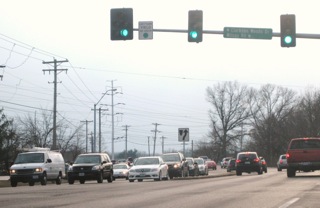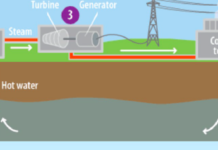Each day, more than 200 million people in the United States get behind the wheel of their cars, but do they realize what else they are doing each time they put their key into the ignition? Automobiles, along with certain emissions from factories, have become one of the biggest sources of a pollutant called ground-level ozone, which is creating increasingly serious health problems for all living things, according to the U.S. Environmental Protection Agency (EPA).
wheel of their cars, but do they realize what else they are doing each time they put their key into the ignition? Automobiles, along with certain emissions from factories, have become one of the biggest sources of a pollutant called ground-level ozone, which is creating increasingly serious health problems for all living things, according to the U.S. Environmental Protection Agency (EPA).
Most of the oxygen found in the air is O2, but ozone is O3. Ground-level ozone can form in many different ways; it can be produced naturally or through certain human activities. One way ozone is formed is through a chemical reaction between oxides of nitrogen (NOx) and volatile organic compounds (VOCs) from gasoline fumes in the presence of sunlight.
However, ozone did not start to become an issue until over a century after its discovery. During the 1970’s and 80’s, scientists began to notice ground level ozone greatly increasing due to factors such as smog from cars and factories. In 1970, Congress passed the Clean Air Act, which authorized the EPA to set, monitor, and enforce national standards for ground level ozone levels as part of the National Ambient Air Quality Standards (NAAQS). Another step forward in the fight against air pollution came in 1990 with the Clean Air Act Amendments. These amendments set forward stricter standards for ozone levels and required that areas with unhealthy amounts of ground-level ozone institute programs that limit the harmful emissions. Since 2008, the standard for ozone levels is 0.075 parts per million over an eight hour averaging time. However, despite the best efforts of the EPA, some areas are continuing to have problems meeting the proper standards of ground level ozone, including St. Louis, MO.
According to the St. Louis Regional Clean Air Partnership, an environmental partnership whose mission is to increase awareness of regional air quality and encourage activities to reduce air pollution, St. Louis has exceeded the NAAQS each summer since the passing of the Clean Air Act.
Ozone levels vary between the different seasons and times of day. Since ozone needs sunlight and heat to help form, ozone levels tend to be higher during the day and decrease as the amount of sunlight decreases. Similarly, summer is the peak season for ozone levels since there is a lot of sunshine and heat present along with the ingredient gases, NOx and VOCs.
The American Lung Association also has a color-coded Air Quality Index to indicate ground level ozone levels. Green means good, yellow is moderate, orange indicates unhealthy to sensitive population, red equals unhealthy, and purple warns very unhealthy. According to the American Lung Association, between 2006 and 2008, St. Louis County had a total of 42 orange ozone days and 5 red ozone days, and St. Louis City had 27 orange ozone days and 2 red ozone days. Both St. Louis County and St. Louis City were assigned an ozone grade of “F”, which is given to any county that had 9 or more days over the standard including at least 1 or more red or purple day.
One of the reasons why St. Louis and other areas continue to have problems with ground-level ozone is that its citizens are extremely automobile dependent. According to the St. Louis Regional Clean Air Partnership, St. Louisans make about 7.2 million automobile trips each day, 5.3 million of which are single-occupancy trips.
Perhaps this amount of daily transportation could be lessened if St. Louis had a more active public transportation system. According to Metro Transit St. Louis, the various forms of public transportation take about 45,000 vehicles off of the road every day. On the other hand, public transit in Chicago takes around 400,000 vehicles off of the road each day and therefore, significantly lower the amount of pollution caused by gasoline fumes as well.
In a study conducted by the Harvard School of Public Health in 1996, hospital visits in 13 American cities, including St. Louis, were compared to ground-level ozone levels. The study found that respiratory-related emergency room visits in the St. Louis area increased by about 7.3% on days of high air pollution. If the national standards of ground-level ozone continue to not be met, people and several areas of the environment will be harmed.
Susannah Fuchs, Senior Director of Environmental Health for the American Lung Association, says the reason why ground level ozone continues to be an issue is because it “has a grave impact on health and the environment, causing and exacerbating many types of lung disease and other health issues, plus it causes crop damage, which then can lead to serious economic impact.”
Along with lung disease, repeated exposure to ground-level ozone can reduce lung function, inflame the linings of the lungs, or permanently scar lung tissue, according to the EPA. The EPA states that in addition to causing health problems for humans and animals, ozone can harm plants by interfering with their ability to produce food, making them more susceptible to disease and sometimes causing death. The EPA estimates that ozone is responsible for about $500 million in reduced crop production each year in the United States.
In response to the Clean Air Act Amendments of 1990, several steps have been taken to help reduce ground-level ozone, including funding research and development on cleaner cars and fuels, establishing vehicle emissions inspection programs, and using special nozzles at gas pumps to recapture gasoline vapors.
However, there are also several steps everyone can take to help reduce the amount of ground-level ozone. Fuchs says, “The easiest thing for the average person to do is to be mindful about transportation – carpool whenever possible, don’t idle the vehicle, and make sure that personal automobiles are properly maintained.”

This work is licensed under a Creative Commons Attribution-NonCommercial-NoDerivs 3.0 Unported License














Wow! What a great article! You did a great job of explaining the science in simple terms, and of attributing your information. Also your article has great contextualization with the history you provided about the congressional actions, and you used outstanding examples of credible sources- EPA, American Lung Association, etc…
But what I liked most about your article was the local angle about Saint Louis ozone emissions. I might have moved this part to the beginning of the article, as it is extremely relevant to people who live in the area, and it’s good to get the most important information out first. That said, you did a wonderful job!
This article was very good! I don’t know much of anything about the ozone and I was able to understand this article very clearly!
This article was so interesting! I never had thought about the levels of ozone like this before!
Emily, Great Article! Really enjoyed reading it!